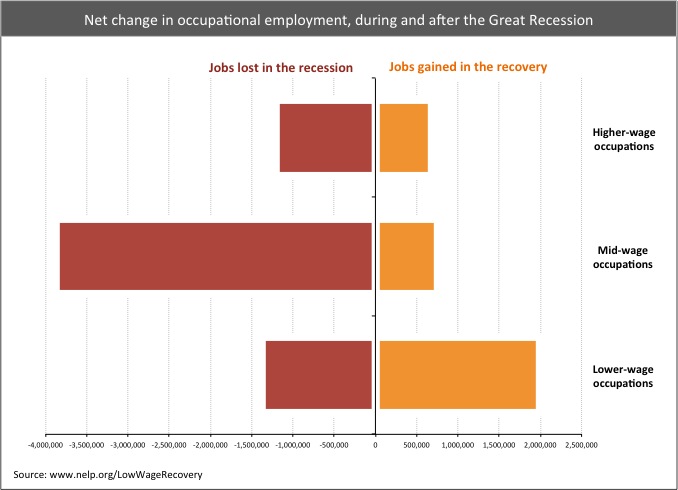The latest job trends update from the National Employment Law Project finds lower-wage employment grew 2.7 times faster than mid- and higher-wage occupations during the economic recovery:
- Lower-wage occupations ($7.69 – $13.83/hr.) were 21 percent of recession losses, but 58 percent of recovery growth.
- Mid-wage occupations ($13.84 – $21.13/hr.) were 60 percent of recession losses, but only 22 percent of recovery growth.
- Higher-wage occupations ($21.14 – $54.55/hr.) were 19 percent of recession job losses, and 20 percent of recovery growth.

Lower-wage employment grew 2.7 times faster than mid- and higher-wage occupations during the economic recovery.
Low-wage jobs with the biggest growth during the recovery include retail salespersons, food preparation workers, laborers and freight workers, waiters and waitresses, personal and home care aides, and office clerks and customer representatives.
Industry dynamics are playing an important role here. Just three low-wage industries (food services, retail, and employment services) added 1.7 million jobs over the past two years, fully 43 percent of net employment growth – while better-paying industries (such as construction, manufacturing, finance, insurance and real estate, and information) did not grow, or did not grow enough to make up for recession losses.
Other better-paying industries (like professional and technical services) saw solid growth, but not in their mid-wage occupations. And steep cuts in state and local government have hitmid- and higher-wage occupations the hardest.
It’s the latest in a continuing trend: since the first quarter of 2001, employment has grown by 8.7 percent in lower-wage occupations and by 6.6 percent in higher-wage occupations. By contrast, employment in mid-wage occupations has fallen by 7.3 percent. Meanwhile, real median wages for lower-wage and mid-wage occupations declined (by 2.1 and 0.2 percent, respectively), but increased for higher-wage occupations (by 4.1 percent).
Annette Bernhardt, the report’s author, says restoring jobs that can support a family will require major public policy changes:
“If we want to understand what’s happened to the average American worker over the past 30 years, we have to look at the decline in the real value of the minimum wage. We have to look at deunionization. We have to look at the growth of subcontracting and contingent work. And frankly, we have to acknowledge that the post-war social contract is broken. We’ve seen strong productivity growth over the last 30 years, but the majority of workers have not seen that translate into their paychecks,” said Bernhardt.
“There is no single magic bullet, but there are plenty of policies we could institute right nowthat would help enormously. We need to extend unemployment benefits, raise the minimum wage, create jobs by repairing our infrastructure, and help our states avoid more layoffs of teachers, cops and firefighters. It’s just a question of political will and leadership,” she said.
The National Employment Law Project is a non-partisan, not-for-profit organization that conducts research and advocates on issues affecting low-wage and unemployed workers. For more about NELP, visit www.nelp.org.
More To Read
April 17, 2024
2023-24 Impact and Gratitude Report
Reflecting on a year of progress and transition at EOI
April 12, 2024
Welcoming our New Executive Director, Rian Watt!
EOI is excited to begin its next chapter under new leadership
April 4, 2024
Is There a Valid Argument Against Cost-Free College in Washington?
Cost-free college is a meaningful investment that would change lives. What's stopping Washington from making it happen?
